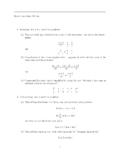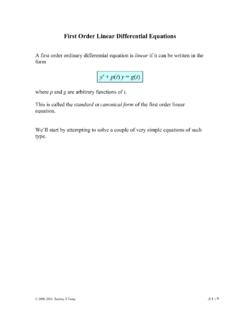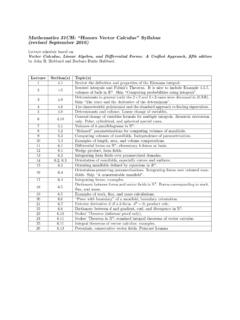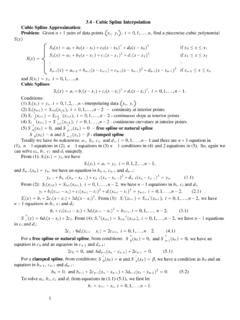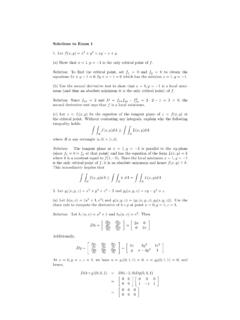Transcription of 20D - Homework Assignment 1 - UCSD Mathematics
1 Brian Bowers (TA for Hui Sun)MATH 20 DHomework Assignment 1 October 7, 201320D - Homework Assignment #1,2,3,4,6 Solve the given differential equation.(1)y =x2/y(2)y =x2/y(1 +x3)(3)y +y2sinx= 0(4)y = (3x2 1)/(3 + 2y)(6)xy = (1 y2)1/2 All of the equations in this set are separable, so our goal should be to get the terms involvingyon theleft side and the terms involvingxon the right side. I will rewritey asdy/dxfor these problems.(1)We separate and then integrate:dydx=x2/y= ydy=x2dx[separating variables]= y22=x33+C[integrating]= y= 2x33+C[solving fory](2)We separate and then integrate:dydx=x2/y(1 +x3)= ydy=x21 +x3dx[separating variables]= y22=13ln|1 +x3|+C[integrating]= y= 23ln|1 +x3|+C[solving fory](3)We separate and then integrate:dydx= y2sinx= dyy2= sinxdx[separating variables]= 1y= cosx+C[integrating]= y= 1cosx+C[solving fory]1(4)We separate and then integrate.
2 Dydx= (3x2 1)/(3 + 2y)= (3 + 2y)dy= (3x2 1)dx[separating variables]= 3y+y2=x3 x+C[integrating]= (y+ 3/2)2=x3 x+C[completing the square]= y= x3 x+C 3/2 [solving fory](6)We separate and then integrate:xdydx= (1 y2)1/2= (1 y2) 1/2dy=dxx[separating variables]= sin 1(y) = ln|x|+C[integrating]= y= sin(ln|x|+C) [solving fory] #9a, 17a, 19aFind the solution of the given initial value problem in explicit form.(9a)y = (1 2x)y2, y(0) = 1/6(17a)y = (3x2 ex)/(2y 5), y(0) = 1(19a)sin 2xdx+ cos 3ydy= 0, y( /2) = /3 First, we should clarify what it means to find an explicit solution - an explicit solution is a solution ofthe formy=f(x) (as opposed to something likey2+y=x3+ 1).
3 Once again, for each problem, I will writey asdy/dxfor ease of separation.(9a)We separate and then integrate:dydx= (1 2x)y2= dyy2= (1 2x)dx[separating variables]= y 1=x x2+C[integrating]= y= 1x x2+C[solving fory]Next, we plug in our initial condition:y(0) = 1(0) (0)2+C= 1C= 16,which we can solve to get thatC= 6. Thus, plugging back into our solution fory, we gety= 1x x2+ 6.(17a)We separate and then integrate:dydx= (3x2 ex)/(2y 5)= (2y 5)dy= (3x2 ex)dx[separating variables]= y2 5y=x3 ex+C[integrating]= (y 52)2=x3 ex+C[completing the square]= y= x3 ex+C+52[solving fory]Next, we plug in our initial condition:y(0) = (0)3 e(0)+C+52= C 1 +52= , we find that C 1 = 32.
4 But the square root of a number is always positive, so we choose thenegative sign and get C 1 = 32, which we can solve to find thatC=134. Thus, plugging backinto our solution fory, we gety= x3 ex+134+ that our final solution only involves the negative of the square root since this is what we foundfrom our initial (19a)We separate and then integrate:sin 2xdx+ cos 3ydy= 0= cos 3ydy= sin 2xdx[separating variables]= 13sin 3y=12cos 2x+C[integrating]Next, we plug in our initial condition (which says that whenx= /2, we havey= /3):13sin(3( /3)) =12cos(2( /2)) +C= 13sin( ) =12cos( ) +C= 0 = 12+C= C=12 Next, recall the following facts.
5 Sin(x) = sin( x)andsin(x) = sin(x+ 2 k) for any , we get the solution13sin(3y) =12cos(2x) +12= sin(3y) =3 cos(2x) + 32= y=sin 1(3 cos(2x)+32)+ 2k 3or sin 1(3 cos(2x)+32)+ 2k 3If we plug our initial condition into the first formula, we get 3=sin 1(3 cos(2( /2))+32)+ 2k 3=sin 1(0) + 2k 3=2k 3,but this solves tok= 1/2, which is not an integer. So, we consider the second formula: 3= sin 1(3 cos(2( /2))+32)+ 2k 3= sin 1(0) + 2k 3= + 2k 3,which solves ask= 0. Thus, our final explicit formula should be the second formula withk= 0,namelyy= sin 1(3 cos(2x)+32) #30(abcde)Consider the equationdydx=y 4xx y.
6 (1)(a) Show that equation (??) can be rewritten asdydx=(y/x) 41 (y/x);(2)thus Equation (??) is homogeneous.(b) Introduce a new dependent variablevso thatv=y/xory=xv(x). Expressdy/dxin terms ofx,v,anddv/dx.(c) Replaceyanddy/dxin Equation (??) by the expressions from part (b) that that the resulting differential equation isv+xdvdx=v 41 v,orxdvdx=v2 41 v(3). Observe that Equation (??) is separable(d) Solve Equation (??), obtainingvimplicitly in terms ofx.(e) Find the solution of Equation (??) by replacingvbyy/xin the solution in part (d).First, I think it s worth clarifying what homogeneous means in this context.
7 We are using the definitiongiven on pages 49-50, namely If the right side of the equationdy/dx=f(x,y) can be expressed as a functionof the ratioy/xonly, then the equation is said to be homogeneous. Now let s work through the problem:(a) In order to rewrite an equation, we want to modify it in such a way that the content remains this case, we achieve this by multiplying the right side of the equation by 1 in a special 4xx ydydx=(1/x1/x)y 4xx y[multiplying by 1]dydx=(y/x) 41 (y/x)[simplifying]Thus, since the right side of the equation is expressed solely in terms of y/x , we conclude that theequation is homogeneous.
8 (b) Definev=y/x. If we solve fory, we gety=xv. Differentiating with respect tox, we use the productrule to getdy/dx=v+ (c) Next, we plug substitutey/x=vanddy/dx=v+xdvdx:v+xdvdx= v 41 v= xdvdx=v 41 v v[rearranging]= xdvdx=v 41 v v v21 v[getting a common denominator]= xdvdx=v2 41 v[combining terms]We could rearrange terms to write this asdv(1 v)v2 4=dxx,(4)which means that this equation is separable.(d) Now we solve Equation (??) using the separated version, Equation (??). In order to integrate the leftside of Equation (??), we will need to use partial fractional decomposition.
9 We need to findAandBsuch that1 vv2 4=Av 2+Bv+ 2=A(v+ 2) +B(v 2)v2 4=(A+B)v+ (2A 2B)v2 , comparing the terms withvwe see that 1 =A+B, and comparing the constant terms, we seethat 1 = 2A 2B. The first equation tells us thatA= 1 B. Pluggin this into the second equationwe get2( 1 B) 2B= 4B 2 = 1,which we can solve to getB= 3/4. Substitution this back into our first equation, we get 1 =A 3/4,which we can solve to getA= 1/4. Thus, we can rewrite Equation (??) as( 1/4v 2+ 3/4v+ 2)dv=dxx= 14ln|v 2| 34ln|v+ 2|= ln|x|+C[integrating](e) Last, we substitutev=y/xeverywhere in our solution.
10 We get 14ln|(y/x) 2| 34ln|(y/x) + 2|= ln|x|+ is technically a correct solution to the differential equation and we could end the problem here, butwe have to do a bit of work to make this a simpler form (specifically a simpler form that matches theanswer given in the back of the book.) If you re interested to see how to get the nicer form, read the6following steps. If not, feel free to stop the problem 14ln y 2xx 34ln y+ 2xx = ln|x|+C[common denominator]= ln y 2xx 1/4+ ln y+ 2xx 3/4= ln|x|+C[properties of logs]= eln|y 2xx| 1/4+ln|y+2xx| 3/4=eln|x|+C[exponentiating]= eln|y 2xx| 1/4eln|y+2xx| 3/4=eln|x|eC[properties of exponents]= y 2xx 1/4 y+ 2xx 3/4=C|x|[simplifying, renamingC]= |y 2x| 1/4(1|x|) 1/4|y+ 2x| 3/4(1|x|)


